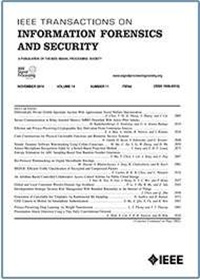一种多尺度判别攻击调制自动分类方法
IF 8
1区 计算机科学
Q1 COMPUTER SCIENCE, THEORY & METHODS
IEEE Transactions on Information Forensics and Security
Pub Date : 2024-12-11
DOI:10.1109/TIFS.2024.3515802
引用次数: 0
摘要
面向自动调制分类(AMC)的深度神经网络(adnn)由于其广泛的应用,近年来受到了广泛的关注。然而,它们很容易受到攻击。带有弱扰动的调制信号的对抗性示例(AEs)可以很容易地欺骗adnn。在AMC上进行AEs的研究,一方面可以提高无线通信系统的安全性;另一方面,它可以为潜在的攻击提供有效的防御。然而,大多数现有的攻击方法产生的AEs具有较低的可转移性。提出了一种针对调制信号的多尺度判别攻击方法(MDAM)。该方法通过消除多层的判别特征来缓解可转移性问题。具体来说,我们利用可解释的类激活图来区分区分区域,忽略噪声,专注于区分特征的干扰。除此之外,我们提出了多层激活中断损失来约束中间层的激活。这样,ae就不会错误地保留原始信号的深层特征。我们在RadioML数据集和我们收集的局域网(LAN)通信数据集上进行了广泛的实验,以评估MDAM在白盒和黑盒攻击场景下的有效性。结果表明,该方法优于现有方法。本文章由计算机程序翻译,如有差异,请以英文原文为准。
A Multiscale Discriminative Attack Method for Automatic Modulation Classification
Automatic Modulation Classification (AMC)-oriented Deep Neural Networks (ADNNs) have received much attention in recent years for their wide range of applications. However, they are vulnerable to attacks. Adversarial Examples (AEs) of modulation signals with added weak perturbations can easily fool ADNNs. The study of AEs on AMC, on one side, can enhance the security of wireless communication systems; on the other side, it can provide an effective defence against potential attacks. Nevertheless, most existing attack methods generate AEs with low transferability. In this paper, we propose a Multiscale Discriminative Attack Method (MDAM) for modulated signals. The method strives to alleviate such transferability issue by destroying discriminative features in multi-layer. Specifically, we utilize interpretable class activation maps to distinguish the discriminative regions, ignoring the noise and focusing on the interference of the discriminative features. Beyond that, we propose a multi-layer activation disruption loss to constrain activations in the middle layers. In so doing, the AEs do not erroneously retain deep features of the original signal. We conduct extensive experiments on RadioML datasets and the local area network (LAN) communication dataset we collected to evaluate the effectiveness of MDAM in both white-box and black-box attack scenarios. The results show that MDAM outperforms existing methods.
求助全文
通过发布文献求助,成功后即可免费获取论文全文。
去求助
来源期刊

IEEE Transactions on Information Forensics and Security
工程技术-工程:电子与电气
CiteScore
14.40
自引率
7.40%
发文量
234
审稿时长
6.5 months
期刊介绍:
The IEEE Transactions on Information Forensics and Security covers the sciences, technologies, and applications relating to information forensics, information security, biometrics, surveillance and systems applications that incorporate these features
 求助内容:
求助内容: 应助结果提醒方式:
应助结果提醒方式:


